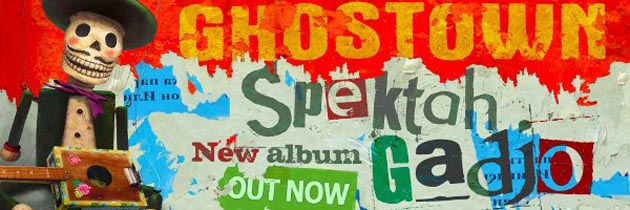With inspiration ranging all the way from grime to flamenco, listening to the French hiphop outfit Ghostown is a bit like turning the frequency knob on a radio receiving signals from all corners of the world. Rael Powell, the beatsmith and vocalist of the project, explains how he masters his loops.

What are you looking for in terms of groove and vibe?
I’m a hook man. Ever since my earliest musical memories I have been fond of repetetive stuff oriented towards drums. Later on, as I would often find the first few bars of songs more interesting than the whole song, hiphop just fell naturally into my world.
So I’m mostly looking for a hook or groove and then it’s a question of working with that riff, finding what goes with it, finding things to do with it, break it down and change it without interrupting the overall flow of the song.
How do you incorporate the Octatrack in your workflow?
Most of the material on the latest album already existed before I bought the Octatrack back in November 2011. I became inspired reading about the Machinedrum and that article led me to the Octatrack. I became hopelessly seduced and had to endebt myself to pursue my dreams!
The idea behind using the Octatrack was to open up for breaks and variations of each riff, sample or song. That’s exactly what I started to do, but within a few weeks I realised I had been re-sampling everything and had basically started re-working the whole album from scratch! It also meant I had the songs in a format which allowed me to mess around with the samples quite extensively when playing live.
The Octatrack has today become my master sampler and sequencer. I often create loops I am perfectly happy with by using keys, guitar and the MPC. Then I chop up the samples in the Octatrack just to see what might come out of it, often ending up with more interesting loops than the original ones. I then use the arranger to sequence the song from A – Z, each pattern in a bank representing different variations, breaks, choruses etc. Scenes also get heavily used. I record to my multitracker, a Korg D3200. Because I am multitracking track by track, I can get creative with crossfader scenes for each track, something that turned out particularly interesting on the song “Hat Stand”.
The LFO Designer, and the LFOs in general, works like a dream together with the various FX. That was one of the main selling points for me. People using software have access to similar features, but as I used an MPC I couldn’t obtain what I wanted.
Recently I’ve started experimenting with controlling the pickup machines with a foot pedal, the Behringer FCB1010. I am eager to see what that brings as I envisage that workflow being a part of my live setup.
What moment do you spend the most time on when producing? Sound design, arranging or mixing?
Probably arranging. I spend a lot of time playing the keys and searching for the right sound. Then programming, chopping things up and adding FX. The mix is often set right at the start and isn’t altered that much.
In your music, what do you feel is the most essential part? What needs to be there for you to be satisfied with a track?
The track needs to grab me in one way or another, making me feel something, making me want to move my body. That is the most essential for me I guess. A four track demo could showcase as much of those qualities as something coming from the studio of a mega-producer.
Visit Ghostown on Facebook and on Soundcloud. Get the “Spektah Gadjo” album on BandCamp.

